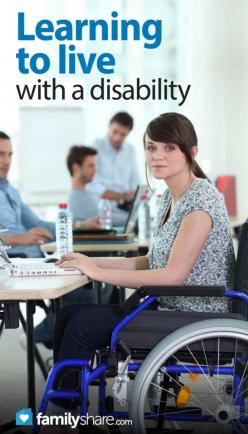
Growing up with a disability during the 1950s and 1960s, there were few laws that granted rights to people with disabilities. Society didn't even recognize the disabled community. It was not until the 1970s that people with disabilities became recognized and laws governing their rights were enacted. In 1977, the Individual Disability Education Act (IDEA), was passed and for the first time, people with disabilities were guaranteed the right to an education up to the age of 21. However, because you had so many people with disabilities graduating from college with few employment opportunities, Congress passed the Americans with Disabilities Act (ADA). This law addressed both employment and accessibility.
Accessibility means employers have to adapt their workplace to meet the needs of disabled employees. This means for someone who is blind, the building will need to be open with few blockages. Hallways must be wide enough for a wheelchair to pass through. Specialized equipment must be available to meet the needs of the physically disabled.
For someone who is newly disabled, their first course of action should be to find out what their legal rights are for accessibility and employment.
Rehabilitation Services is a government organization that trains people with disabilities for gainful employment. The private sector of Rehabilitation Services works with someone who has been injured on the job and needs to be retrained for a different job. The public sector of Rehabilitation Services works with people who were born with disabilities that need a post-secondary education and training for gainful employment.
When retrofitting a home for a disabled person, the agency to contact is the American Disabilities Act Accessibility Guidelines (ADAAG). This agency provides the recommended dimensions for retrofitting a home for someone with a disability. To find a booklet with this information, you can contact the Disability Business Technical Assistance Center (DBTAC). They are divided into eight regions; therefore, you need to know which region you live in and where the location for the agency is in your region.
Adjusting to having a disability is a mindset. It is based not only on your self-image, but how the people around you respond to you as an individual. Society in the 21st century is much more accepting of someone with a disability than they were in the 20th century, but there is still a long way to go before people with disabilities will become fully integrated into society without experiencing prejudice.
Often the relationship that an individual with a disability has with her family influences her self-image and how she sees herself as a member of society. Your own experiences before you became disabled can also impact your self-image. Therefore, you may have to learn to love yourself as you are now instead of how you perceive yourself and what your place in society was in the past. There are mental health agencies, agencies that serve your particular disability, and support groups that can help you learn to love yourself as you are and accept your new limitations.
In my case, I have cerebral palsy, which affects the right side of my body. I also found that one side of my body grew at a faster pace than the other. Because I can only use one hand, I had to learn to tie my shoes using only one hand. In school, I learned to type with one hand. With technology and computers, I use software called Dragon Naturally Speaking, a speech to text software that enables me to dictate to the software what I want written on the page and it does my typing for me. This article was written using that software.
For someone who is visually impaired, there is software available that reads back to the individual what is on the written page. Many articles can be reprinted in large print for someone who has limited vision.
For someone who can no longer use both hands or legs to drive, there is adaptive equipment available that enables you to perform these tasks. Often, cars and special vans can be adapted to meet the needs of the individual. Car dealerships are able to retrofit vans for someone in a wheelchair. There are agencies who sell adaptive equipment for individuals to retrofit their own automobiles.
Finally, the best solution to your problem is to contact the agency that serves your specific disability. Whether it is a spinal cord injury, loss of sight, or a physical disability, they can tell you where to go for the resources and adaptive equipment to meet your specific needs.
It is important to learn what your rights are so you can advocate for yourself. Or you can find a social worker or therapist that can advocate for you. This person can help ensure that you get the services and equipment you need to live a full and productive life in spite of your disability.

